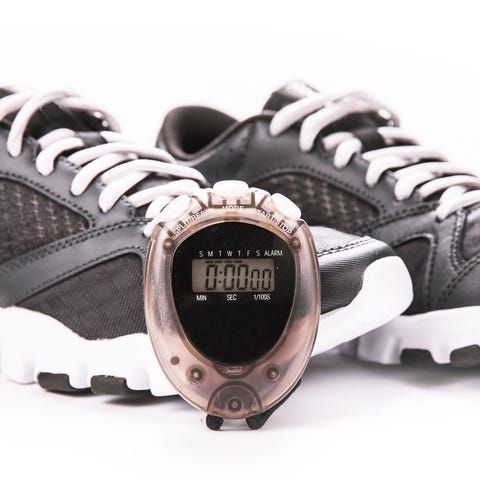
Mark Peterson, Ph.D., is an associate professor of physical medicine and rehabilitation at the University of Michigan.

.
The ultra-short workout has always been all the rage. And thanks to the rise of the “tabata” class, it’s even more viral now. But is it for you?
MH Advisor Mark Peterson, Ph.D., associate professor of physical medicine and rehabilitation at the University of Michigan, isn’t so sure. Peterson, an associate professor at the University of Michigan who researches resistance training for metabolic health and predictors of muscle aging , knows all about the trend, and he gets its appeal. He’s heard the recent arguments too, that dare to compare a two-minute workout to a 90-minute run.
And he doesn’t hate the idea, either. But it comes with a few qualifiers, which he broke down for menshealth.com in a quick Q&A. His main thought on the two-minute workout: It beats no minutes of working out.
But you can do better, too.
Where Did the 2-minute Workout Come From?
It all started with the rise of the “tabata” class, which got its start when Japanese scientist Izumi Tabata (of course!) helped show that the ultra-short workout could work.
Tabata’s original study compared two groups of cyclists for six weeks. One group rode for an hour, 5 times per week, at 70 percent of their maximum capacity. The other group rode for just 4 minutes, 4 times per week, riding in spurts of 20 seconds at 170 percent of their VO2Max (the body’s ability to move oxygen to muscles). Guess who had better cardiovascular results at the end of six weeks? Yup, the group that road in spurts.

Getty Imagesg-stockstudio
Then the journal Clinical Science explored the hyper-speed workout in 2012. Nine physically active men in their 20s, with body fat percentages between 15 and 20 percent, either did nothing, walked for 30 minutes, or did 5 max-effort, 30-second sprints, resting 4 minutes between each. The next day, when they all ate high-fat breakfasts and had lunch three hours later, the the men who ran sprints had less fat in their blood than any group. The study claimed the amount of fat they had in their blood was similar to what would be expected from a 90-minute run, then concluded that “a two-minute workout is as good as 90-minute run.”
Peterson’s Take
“The tagline is total clickbait. For two minutes of exercise to be as good as 30 [or 90] minutes, well, that kind of depends on what you’re striving for. If you’re striving for running a marathon, then no, two minutes is not as good as 30 minutes. If you’re striving for weight loss, two minutes is not as good as 30 minutes.
Comparing the two-minute workout to a 90-minute run is “total clickbait”.
“It’s somewhat misleading to the general public that two minutes of exercise is as good as 30 minutes, especially when it comes about at the exact same time the new physical activity guidelines, which calls for a substantially greater volume of exercise than two minutes.”

Getty ImagesSerbogachuk
Going “all-out” in any workout is harder than you think.
We used to do a cycle ergometer test called the Wingate test. It’s a 30-second, all-out, maximal exertion test. It lasts only 30 seconds. Most people, if they’re truly doing it as hard as they can possibly do it, which is what these sort of 2-minute exercise studies are suggesting you do … most people feel like vomiting at the end of the 30 seconds. Imagine doing 4 rounds of all-out 30-second sprints. And in the Tabata study, participants did their sprints at 170 percent of their VO2Max. It’s very unlikely that many people are doing that level of intensity.
The 7-minute workout is better — but it’s still not enough.
So 7 minutes, even if it’s 7 minutes of walking, certainly, it’s better than nothing.
But 7 minutes is a pretty low dose of exercise for most people. It’s a starting point that you can progress from very quickly. My whole thing is that there needs to be, when someone experiences adaptation, they need to increase the dosage. So if somebody does 7 minutes for a couple of weeks and they’re starting to realize that this exercise isn’t even making me increase respiration, I’m not sweating, it doesn’t feel hard anymore. Then guess what? We need to do more than 7 minutes and we probably need to increase the intensity beyond just bodyweight and include some additional loading.
You can’t keep thinking of doing “the minimum” in the gym.
If you want to say the entry dose for someone who has never worked out in their life, one set of training for each muscle group two times per week. Yes, I can endorse that.

Getty ImagesBojan89
However, within two or three weeks, that’s no longer the minimum dose. That needs to be increased. The dose always needs to increase alongside adaptation, alongside that response. Physiology is amazing. Adaptation happens very quickly. We’re talking days, not weeks.
Train so you enjoy it — and can do it for longer than 15 minutes!
If you have 15 minutes to work out, you’d better use that 15 minutes to work out and get as much out of it as you can.
The thing about it is that some people don’t want to work out for a really long time. To that I would say: Whatever you like to do, do it! If that’s taking a 15-minute bike ride in the morning and a 10-minute walk in the evening, great. I would totally endorse that if, in lieu of that, you’re going to do nothing. Then that’s, to me, the best thing ever for you.
Source: Read Full Article